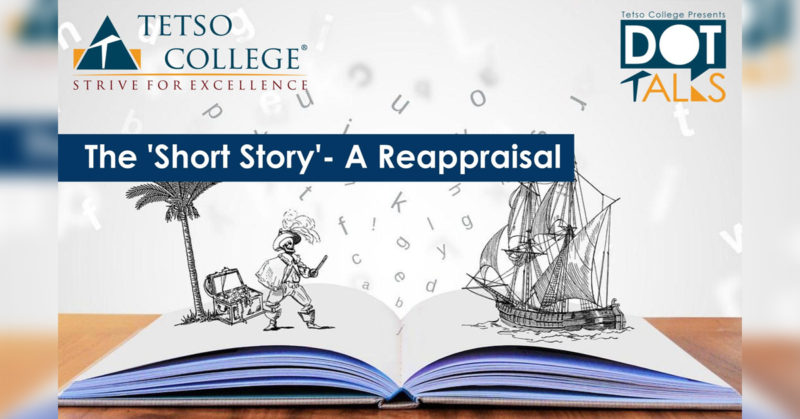DOT Talks holds first Webinar Series
Topic Title: The ‘Short Story’- A Reappraisal with Dr. Ananya Ghoshal
DOT Talks conducted its first webinar series on the topic ‘The Short Story – A Reappraisal’ on April 20, 2020. The resource person was Dr. Ananya Ghoshal, Assistant Professor of English in the School of Humanities and Social Sciences at IIT Indore.
The purpose of the talk was to provide an insight into the literary genre of short stories with an emphasis on its structure, elements, formats, techniques, etc. of storytelling. A summary of the talk is provided below:
What is a Short Story?
A simple way to define a short story is to adhere it to a certain length. The Science Fiction and Fantasy Writers of America, in its Nebula Award for Science Fiction submission guidelines, defines a short story as having less than 7,500 words. In general, length definitions for short stories may run from 1,000 to 20,000 words. In the publishing world, the different types of short stories according to length are Traditional (1,500 – 5,000 words), Flash Fiction (500 – 1,000 words), and Micro Fiction (5 – 350 words).
*The most common and acceptable word range for a short story is still in the 1,500 – 3,000 range.
A Few Definitions of Short Story by Famous Authors
H.G. Wells describes the purpose and art of the short story as “the jolly art of making something very bright and moving; it may be horrible or funny or profoundly illuminating, having only this essential, that it should take from fifteen to fifty minutes to read.”
Somerset Maugham thinks that the short story’s desired effect can be achieved by a strict adherence to form: “The short story must have a definite design, which includes a point of departure, a climax and a point of rest; in other words, it must have a plot, the plot pins down and presents a piece of life within the confines of its own construction; in doing it so, it exhibits life to us, as it were under a microscope and enables us to view it more clearly than we can do in the raw.
Hugh Walpole supports this view: “A story should be a story; a record of things happening full of incidents, swift movements, unexpected development, leading through suspense to a climax and a satisfying denouement.”
Edgar Allan Poe emphasized that the short story should have a unity of impression and singleness of purpose: “There should be no word written of which the tendency direct or indirect is not the one pre-established design.”
The concept of the short story as a finished product of art is however opposed by Anton Chekhov according to whom the story is a “slice of life” (the realistic description or representation of events and situations in everyday life) resented suggestively. Chekhov does not round off his stories; he leaves their ends hanging in there so readers may draw their own conclusions.
Elements of a Short Story
- Setting: The time and location in which a story takes place are called setting. There are several aspects of a story’s setting to consider when examining how the setting contributes to a story:
- Place: Geographical location.
- Time: When is the story taking place? Time (Chronological/Psychological?)
- Weather Conditions: Changing seasons (or seasons of/in mind)
- Social conditions: The daily life of the characters might reflect this
- Mood or atmosphere: How does the writer create the ‘mood’ of the story?
- Plot: Exposition > Inciting Incident > Rising Action > Climax > Falling Action > Resolution > Denouement
- Conflict: It is the opposition of forces which ties one incident to another and makes the plot move. There are two types of conflict – external and internal.
- Character: There are two meaning to the word character –
- A person/being in a work of fiction (protagonist/antagonist)
- Characteristics of a person/being (the way people are represented in a film, play or book so that they seem real)
- Point of View: It is the angle from which the story is told –
- Innocent eye – the story is told through the eyes of a child
- Stream of consciousness – Told in a way that makes the reader feel as if they are inside the head of a character
- First-person – the story is told by the protagonist
- Theme: The theme in a piece of fiction is its controlling idea or central insight. It is the underlying meaning or central idea that the author is trying to convey. Some examples are love, death, coming of age, tradition vs. modernity, war, courage, and heroism, good vs. evil, beauty, the circle of life, etc.
Exercise
How to write Microfiction (5 steps from Beth Kander)
Microfiction is a short story written in fewer words but it still has a plot, a beginning, middle and end, conflict, and character(s).
Example: “For sale: Baby shoes. Never worn.” – E. Hemingway
- Come up with a story. Who is your main character? What is their conflict? What happens to them? Where does it happen? Just because your story is very short does not mean you should not try to have vibrant characters in memorable settings.
- Write it out once. Tell the story in more words, add in the details that you think are important. This is your first draft.
- Now edit and let go of all extra words.
- Read all your sentences again. Polish each sentence. Make sure that each word is conveying something – a feeling, an atmosphere, a detail. Your first and your last sentences should receive extra attention.
5. Now add a title. It should contribute to the story as every sentence you have just perfected!

